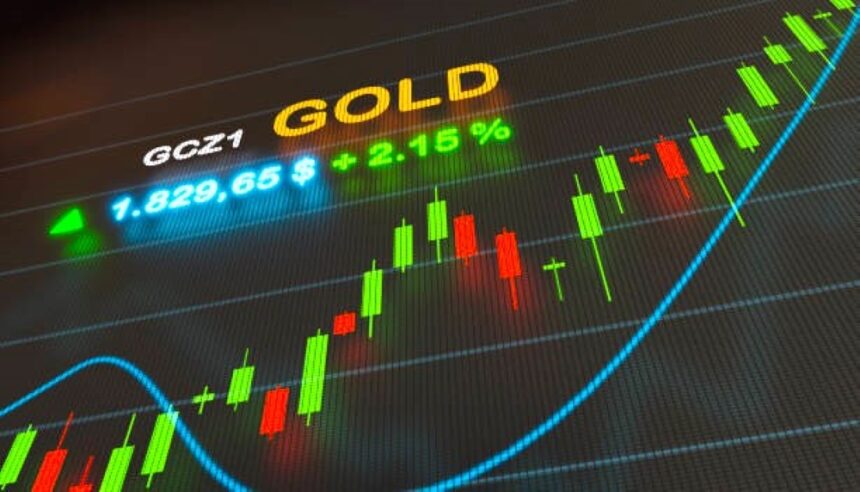Gold Surges on Weekly Gains as US Debt Drama Sparks Safe-Haven Rush.
Gold (XAU/USD) has once again reclaimed the spotlight in global financial markets, surging nearly 1% on Friday and wrapping up the week with an impressive 4% gain. After a volatile few sessions earlier this month, the precious metal has regained its footing, trading near $3,329 at the time of writing. The trigger? Mounting concerns over the United States’ deepening fiscal deficit—an issue that has reignited investor demand for the world’s oldest safe-haven asset.
The latest catalyst came from Washington, D.C., where President Donald Trump’s newly approved spending bill is causing a fresh wave of anxiety. With the bill adding $3.8 billion to the US national debt and the anticipated revenues from tariffs still uncertain, market participants are bracing for prolonged financial instability.
Debt Fears Drive Investors to Gold
What’s driving gold’s rally is more than just the raw numbers—it’s the growing realization that America’s debt spiral may be entering a dangerous phase. The Trump administration’s expansive spending plans—focused on infrastructure, defense, and tax relief—have passed the House and are now pending Senate approval. Traders are increasingly wary that the increased debt load, combined with lagging tariff revenues, will only worsen the fiscal outlook.
This sentiment is clearly reflected in US Treasury yields. The benchmark 30-year yield spiked to 5.15% on Thursday, rising from 4.64% at the beginning of May. That level marks the highest yield seen since December 2023, when it briefly touched 5.18%. Such rapid yield movements signal heightened risk perceptions and rising borrowing costs. As yields surge, investors demand greater compensation for holding US debt, suggesting they see a deteriorating credit profile.
Moody’s Downgrade Adds to Market Anxiety
Fueling the fire is the recent downgrade of the US credit outlook by Moody’s. The agency cited unsustainable fiscal trends and political gridlock as primary concerns. With a downgrade in place, international and institutional investors may further reduce their exposure to US bonds, compounding the yield surge and pressuring the dollar. For gold, these developments are pure fuel. As confidence in fiat currencies wanes, gold shines as a hedge against both inflation and sovereign risk.
Geopolitical Tensions and ETF Demand Reinforce Bullish Case
Beyond fiscal mismanagement, gold’s appeal is being reinforced by broader geopolitical and economic trends. According to Bloomberg, China’s onshore gold-backed ETFs saw a surge in inflows as prices rebounded. On May 21 alone, over 370 million Yuan flowed into some 20 gold ETFs listed on Chinese exchanges. That resurgence signals renewed retail and institutional appetite from one of the world’s biggest gold-consuming nations.
Meanwhile, in Ghana, a quiet gold revolution is underway. The country’s small-scale and artisanal gold producers are contributing to a surge in exports, projected to bring in up to $12 billion annually if output doubles as planned. This uptick is not just about global demand—it’s about countries leveraging gold to boost foreign currency reserves and stabilize trade balances. Ghana has even established a new regulatory authority to manage all gold transactions, hoping to formalize the sector and curb illicit activity.
Diminished Gold-Yield Inverse Correlation Opens Room for Upside
Traditionally, rising bond yields have spelled trouble for gold prices. Since bullion doesn’t offer interest, higher returns on Treasuries usually lure investors away. But that inverse relationship is showing signs of strain. According to Bloomberg, yields on 10-year Treasuries topped 4.5% this week, yet gold still managed a powerful rebound. This suggests that structural changes in the market, such as inflation hedging, de-dollarization, and geopolitical hedges, may now be playing a more significant role than simple opportunity cost calculations.
Analysts agree the correlation is weakening. Justin Lin, an analyst at Global X ETFs, told Bloomberg that gold is likely to remain range-bound in the near term. However, he emphasized that geopolitical tensions and growing concerns about the US fiscal outlook are providing a steady base of support. In other words, gold has found new legs beyond just real yields.
Fed Policy and Inflation Outlook Key to Next Moves
Looking ahead, the Federal Reserve’s policy direction will remain a critical factor for gold. So far, the Fed has maintained a hawkish tone in the face of sticky inflation, with Chair Jerome Powell suggesting that rate cuts may be premature despite market expectations. However, if economic data starts to show weakness or if the bond market becomes too volatile, the Fed could be forced to adopt a more dovish stance.
That possibility plays right into gold’s hands. Any sign of a policy pivot could trigger a renewed surge in the yellow metal, especially if it coincides with heightened fiscal concerns or geopolitical stress. With inflation still hovering above the Fed’s 2% target, even a shallow easing cycle could be seen as real-rate negative, further underpinning gold’s appeal.
Gold Market Outlook: Where to Next?
After this week’s strong performance, gold faces a critical juncture. Technically, a sustained move above $3,330 could open the door toward retesting record highs. Traders will be watching the next resistance near $3,350, followed by a more psychological level around $3,400. On the downside, key support lies near $3,280 and $3,240, levels that held firm during the recent pullback.
From a macro standpoint, gold’s upward momentum appears well-supported. Persistent US fiscal slippage, rising global tensions, and ongoing central bank buying (particularly in emerging markets) are all bullish factors. Central banks, notably from China, India, and Russia, have continued accumulating gold as part of a broader strategy to reduce reliance on the US dollar.
Investor Sentiment Shifting Toward Hard Assets
Another notable trend is the shifting sentiment toward hard assets. With equities facing valuation concerns, and bonds plagued by rising yields and credit risks, many portfolio managers are rebalancing toward real assets. Gold, with its deep liquidity, universal acceptance, and historical resilience, is becoming a favored allocation. Even among retail investors, demand for gold bars and coins remains robust, as trust in traditional institutions wavers.
Additionally, macro hedge funds and sovereign wealth funds are reportedly increasing their gold exposure, viewing it as both a hedge and a potential alpha source in the face of growing macro instability. This institutional flow could provide a longer-term tailwind, helping gold maintain elevated levels even in the face of intermittent corrections.
Conclusion: Gold Set to Stay Golden
In summary, gold’s nearly 4% weekly gain is more than just a technical bounce—it reflects deepening concerns over the US fiscal trajectory, a shift in global investor psychology, and rising geopolitical risks. With yields spiking and trust in US debt instruments declining, gold is reasserting its role as a vital hedge in diversified portfolios.
While short-term price movements may be influenced by profit-taking or economic data surprises, the broader backdrop remains supportive. Unless the US quickly reins in its budget deficits and restores fiscal credibility, gold’s bullish case will likely remain intact. Add to that the persistent global appetite for safe-haven assets, and it’s clear that the path of least resistance for gold remains upward.
[faq-schema id=”39663″]









